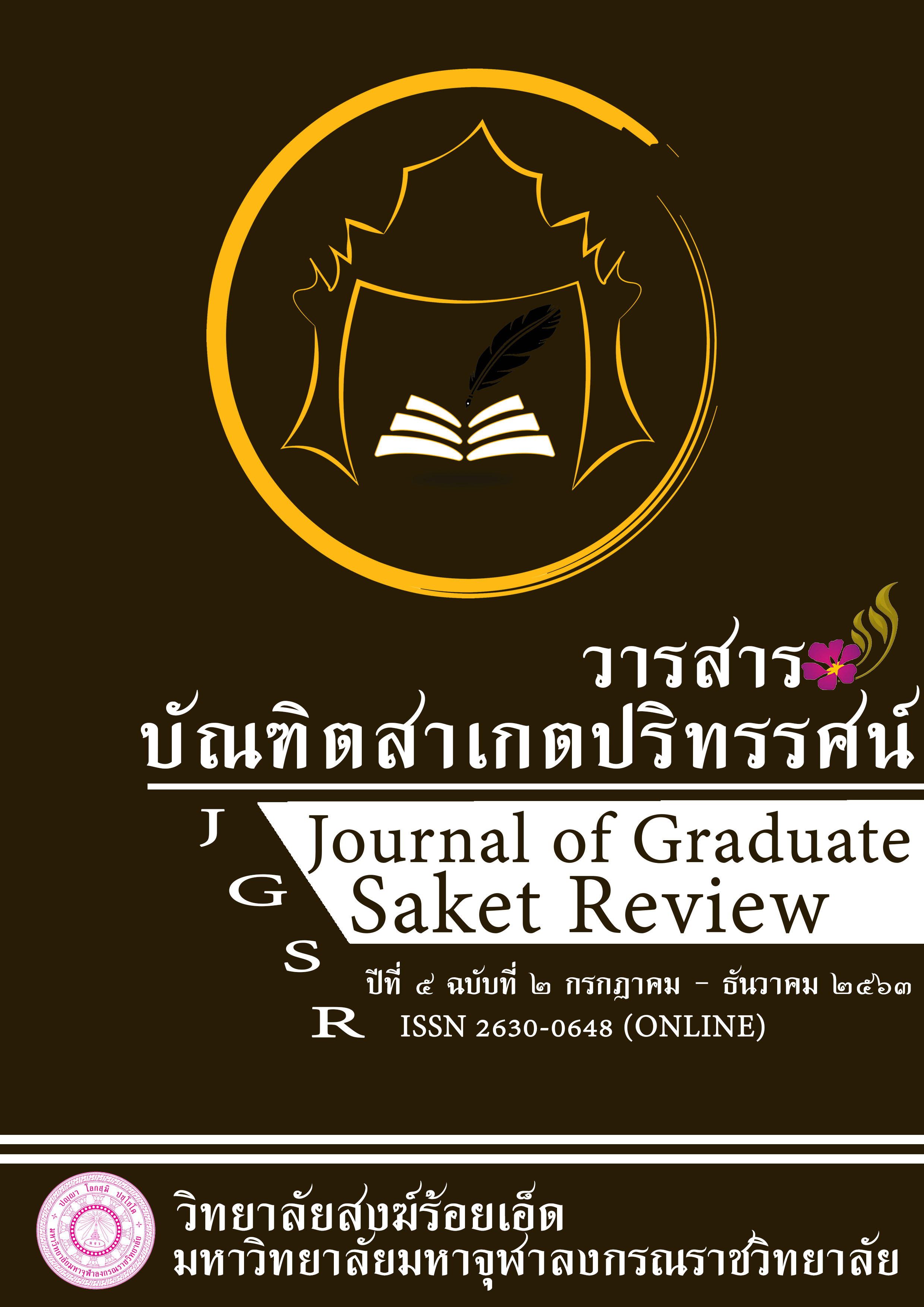Dhammadhipateyya : The rules of goodness
Main Article Content
Abstract
An apply the principles of goodness and badness to judge the conduct of people in society are the standardized and accepted in general society.
In the author’s side, Dhammadhipateyya is Suitable for being the highest standard of goodness. Since Dhammadhipateyya is considered the importance of dhamma and mention of the correctness follow them which the method of determining whether That action is advantage or harmful on life including mind and personality for individual or society to follow the conscience and social standards. Although in the present time is a democratic society which recognize the human right, freedom and equality in society therefore giving importance to people who are mostly voice. While we should be accept the agreement of majority of people cannot guarantee those opinion is always correct because it is only measured in terms of the needs of the majority voice and can not be the measure of good and evil. So, the opinions of most people are not the criteria for judging the good and evil that is the most accurate. The measure of good and evil rely on a Dhamma for regulation. Hence, Dhammadhipateyya is the standard of goodness which will be create harmony and reconciliation in society and nation that is how we must use the process for considering the advantage and blaming the others people and society including to consider by conscience and social standard base on the Dhammadhipateyya importantly.
Article Details
เนื้อหาและข้อมูลในบทความที่ลงตีพิมพ์ในวารสารบัณฑิตสาเกตปริทรรศน์ ถือเป็นข้อคิดเห็นและความรับผิดชอบของผู้เขียนบทความโดยตรงซึ่งกองบรรณาธิการวารสาร ไม่จำเป็นต้องเห็นด้วย หรือร่วมรับผิดชอบใด ๆบทความ ข้อมูล เนื้อหา รูปภาพ ฯลฯ ที่ได้รับการตีพิมพ์ในวารสารบัณฑิตสาเกตปริทรรศน์ ถือเป็นลิขสิทธิ์ของวารสารบัณฑิตสาเกตปริทรรศน์ หากบุคคลหรือหน่วยงานใดต้องการนำทั้งหมดหรือส่วนหนึ่งส่วนใดไปเผยแพร่ต่อหรือเพื่อกระทำการใด ๆ จะต้องได้รับอนุญาตเป็นลายลักอักษรจากวารสารบัณฑิตสาเกตปริทรรศน์ ก่อนเท่านั้น
References
กรมการศาสนา. การทรวงศึกษาธิการ.(2525) พระไตรปิฎกภาษาไทย ฉบับหลวง. เล่มที่ 9,10,15,20.กรุงเทพมหานคร : โรงพิมพ์มหามกุฎราชวิทยาลัย.
คูณ โทขันธ์.(2545). พุทธสาสนากับสังคมและวัฒนธรรมไทย. กรุงเทพมหานคร:โอเดียนสโตร์
เดือน คำดี.(2530). ปัญหาปรัชญา. กรุงเทพมหานคร:โอ.เอส.พริ้นติ้งเฮาส์.
ติช นัทฮันห์.(2533). ศิลปะแห่งอำนาจ. แปลโดย จิตร์ ตัณฑเสถียรและสังฆะหมู่บ้านพลัมประเทศไทย. พิมพ์ครั้งที่ ๕. กรุงเทพมหานคร:สำนักพิมพ์ฟรีมายด์.
ปรีชา ช้างขวัญยืน.(2538). ความคิดทางการเมืองในพระไตรปิฎก. พิมพ์ครั้งที่ 2. กรุงเทพมหานคร:จุฬาลงกรณ์มหาวิทยาลัย.
พระธรรมปิฎก (ป.อ.ปยุตฺโต).(2542). พุทธธรรม ฉบับปรับปรุงขยายความ. กรุงเทพมหานคร: มหาจุฬาลงกรณมหาวิทยาลัย.
พระธรรมปิฎก (ป.อ.ปยุตฺโต). (2542). ธรรมกับไทยในสถานการณ์ปัจจุบัน.กรุงเทพมหานคร:มูลนิธิพุทธธรรม.
พระธรรมปิฎก (ป.อ.ปยุตฺโต). (2545). พจนานุกรมพุทธศาสตร์ ฉบับประมวลธรรม. พิมพ์ครั้งที่ 11.กรุงเทพมหานคร:สหธรรมิก.
พระเมธีธรราภรณ์(ประยูร ธมฺมจิตฺโต).(2536). เปรียบเทียบความคิดพุทธทาส-ซาร์ต.กรุงเทพมหานคร:สำนักพิมพ์ศยาม.
พระราชญาณวิสิฐ (เสริมชัย ชยมงฺคโล). (2552). พระพุทธศาสนา ศาสนาประจำชาติไทย. พิมพ์ครั้งที่ 1.กรุงเทพมหานคร : มหาจุฬาลงกรณราชวิทยาลัย.
พระราชญาณวิสิฐ (เสริมชัย ชยมงฺคโล). (2548) . ธัมมิกสังคมนิยม. กรุงเทพมหานคร:สุขภาพใจ.
มหาวิทยาลัยสุโขทัยธรรมาธิราช.(2548). พื้นฐานทางสังคมและวัฒนธรรมของการเมืองไทย.นนทบุรี :สำนักพิมพ์มหาวิทยาลัยสุโขทัยธรรมาธิราช.
ราชบัณฑิตยสถาน,(2554), ภาษาไทย-พจนานุกรม. พิมพ์ครั้งที่ 2. กรุงเทพมหานคร: นานมีบุ๊คส์พับลิเคชั่นส์.
ว.วชิรเมธี.(2551). ยศ ทรัพย์ อำนาจ เป้าหมายหรือมรรควิธีของชีวิต. กรุงเทพมหานคร:บ้านพระอาทิตย์.
สุธรรม ชูสัตย์สกุล.(2545). เอกสารประกอบการบรรยายปรัชญาเปรียบเทียบ. กรุงเทพมหานคร : มหามกุฎราชวิทยาลัย.


